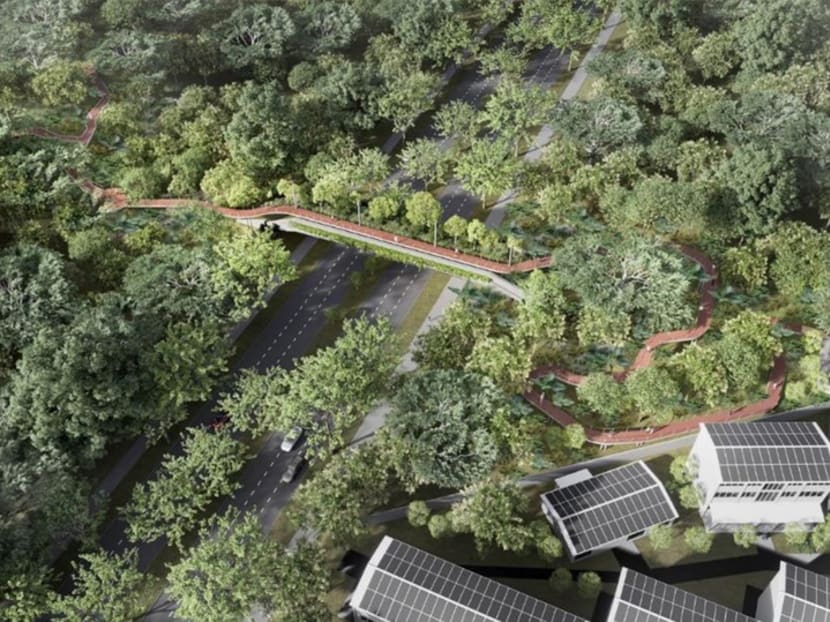Bridge for wildlife, pedestrians to be built by 2026, linking Bukit Batok Nature Park and Bukit Timah Nature Reserve
SINGAPORE — A new bridge for wildlife and pedestrians will be built across Upper Bukit Timah Road by 2026 to link Bukit Batok Nature Park to Bukit Timah Nature Reserve via the Rail Corridor to expand wildlife habitat.

Artist’s impression of the future eco-pedestrian bridge connecting Bukit Batok Nature Park and Bukit Timah Nature Reserve via the Rail Corridor
- An "eco-pedestrian bridge" for wildlife and pedestrians will be constructed across Upper Bukit Timah Road by 2026
- The bridge links Bukit Batok Nature Park to Bukit Timah Nature Reserve via the Rail Corridor
- It will enhance the movement of native species, minimise vehicle-wildlife collisions and complement existing measures helping humans and wildlife to coexist
- The project follows the success of the Eco-Link@BKE used by 100 species of fauna to date
SINGAPORE — A bridge for wildlife and pedestrians will be built across Upper Bukit Timah Road by 2026 to link Bukit Batok Nature Park to Bukit Timah Nature Reserve via the Rail Corridor.
The "eco-pedestrian bridge" is intended to enhance wildlife habitat by linking the two green spaces and reduce the risk of animals being struck by vehicles as they cross busy Upper Bukit Timah Road, among other objectives.
The announcement of the project by the National Parks Board (NParks) on Saturday (May 27) follows the success of the wildlife-only Eco-Link@BKE built in 2013. To date, about 100 wildlife species have been observed there, NParks said.
Planning for the latest bridge is still underway, so it is not yet possible to specify the exact location of the bridge, the board added.
According to a study known as an ecological profiling exercise, completed in 2022, NParks had identified this ecological corridor for animals to traverse between green spaces spanning from Bukit Timah Nature Reserve to the Western Water Catchment.
NParks said the bridge is intended to facilitate the safer movement of native species between green spaces, allowing them to thrive by expanding their habitat and genetic pool, so as to increase their long-term resilience.
'SEAMLESS CONNECTIVITY'
Highlighting the need for the bridge, NParks said that animals have been observed crossing Upper Bukit Timah Road, which lies between the reserve and the park, resulting in collisions with vehicles.
“The new bridge is designed for dual pedestrian-wildlife use and will provide the public with seamless connectivity between the two green spaces,” NParks explained.
Home to more than 1,250 plant species and over 1,800 wildlife species, Bukit Timah Nature Reserve and Bukit Batok Nature Park are areas of core biodiversity, it added.

The eco-pedestrian bridge will complement existing measures in place to help native wildlife move between Thomson Nature Park, Old Upper Thomson Road and Bukit Batok Nature Corridor.
For instance, wildlife species were recorded using multiple canopy linkages, aerial rope bridges and culverts in these areas, observations that provide valuable insights for broader planning purposes.
Rope bridges installed along Old Upper Thomson Road have been used by the critically endangered Raffles banded langur, The Straits Times reported in 2020.
An NParks study to track crossing preferences of wildlife species at Old Upper Thomson road, found that the road was widely used by nocturnal animals when it was closed to vehicular traffic, affirming the importance of having a variety of wildlife crossings.
NParks said that the eco-pedestrian bridge will “build on NParks’ ongoing efforts to facilitate human-wildlife co-existence”.
ECO-LINK@BKE A MODEL OF SUCCESS
The Eco-Link@BKE links Bukit Timah Nature reserve with Central Catchment Nature Reserve, reconnecting the forests of the two nature reserves that were separated after the construction of the BKE in 1986.
Between 2018 and 2021, the Eco-Link@BKE demonstrated its effectiveness as 31 species of fauna were recorded on the bridge for the first time, with the numbers continuing to rise, NParks said.
The 31 species comprised 14 butterfly species, 13 bird species, three mammal species, and one reptile species.
The Eco-Link@BKE is also being used by the native lesser mousedeer, captured through camera traps at least once every month for eight months in the 2021 study, in addition to visual sightings.
More than 3,000 native plants were used to lay the foundations of the connection between the two nature reserves at Eco-Link@BKE.
Other eco-bridges in Singapore include the Mandai Wildlife Bridge, constructed in December 2019, and the 19m wide land bridge that will serve as an eco-link between a hillock and the 12-ha Bidadari Park, announced on May 21, 2023.
CLARIFICATION: An earlier version of this article stated that occasional guided tours of Eco-Link@BKE are conducted for visitors. NParks has clarified that such tours are no longer conducted.









